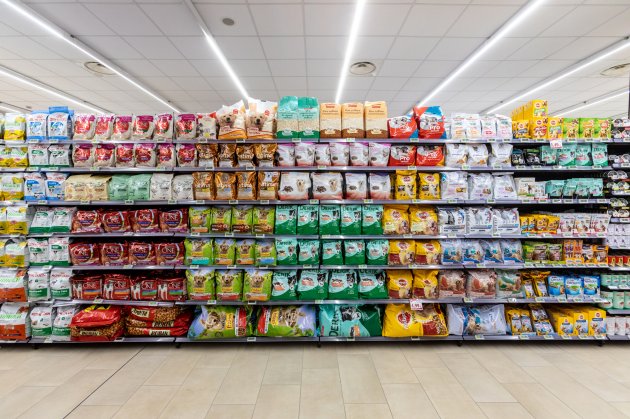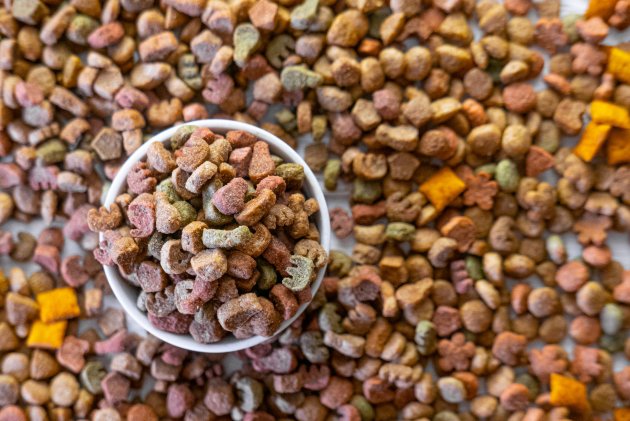As dedicated pet parents, it’s our job to read the labels on the pet food to ensure we are feeding our fur babies the best product possible. However, what is listed on the package can be misleading and may not be what the product actually contains.
In this post, we will explore the 11 ways pet food manufacturers fool customers.

Ingredient Splitting - “Less” Is Still More!
We have been told to always look for meat as the first ingredient in pet food. Manufacturers know this, so they use a technique called “ingredient splitting” to fool us.
This works on two levels.
The label is created before the food is cooked and processed, which makes it weigh considerably more. This enables the company to list the meat at a higher percentage. Rice will also “plump up” when cooked, meaning this starch will weigh more than the meat source that dehydrates when heated.
The starches are broken up into specific units. For example, 30% peas could read; split peas (10%), pea protein (10%), and English peas (10%). This technique makes it appear to have less when it’s really the same.
The “With” Ploy
If your pet food label reads “made with real chicken/beef/salmon etc.” that doesn’t necessarily mean that the meat is the primary source. “With” (in label-speak) is misleading as the food only has to contain 3% of the total weight. What’s the other 97% contain? Read on!

The 100% Organic Mislead
We may feel better when we feed our pets food that ensures us that it was sourced from farms that don’t use pesticides, growth hormones, antibiotics, and all the other bad stuff. However, the truth about any pet food is that it is so highly processed that most of the nutritional integrity has been cooked out of it by the time your pet eats it. Yes, it’s a good thing that the source doesn’t have the bad stuff, but the processing method remains the same.
Made “With” Organic Ingredients
Like the previous “with” this four-letter word is there to mislead the customer. According to the pet manufacturers’ “rules,” “made with organic” ingredients means they only have to include 70% organic foods in the recipe. “All organic” isn’t one hundred percent, either - only 95% of their ingredients must meet this requirement.
“Natural” - Or Is It?
We want our pets to eat natural food but when it comes to pet food labels, this can mean something totally different.
The USDA currently defines “natural” as any food that does not contain artificial ingredients or added color. However, “natural” doesn’t mean the ingredient doesn’t have antibiotics, growth hormones, or other chemicals. And there is currently no difference (legally) between “natural” and “all-natural.”
Gourmet - What Does That Even Mean?
Regardless of how you associate the term “gourmet”, there is currently no legal regulations on how pet food manufacturers can use it.
Feed-Grade Products - AVOID!
Feed-grade is a term used for ingredients that are not safe for human consumption. This can include dead animals from farms/ranches/shelters, fat, grease, and other waste products. Although some manufacturers do use higher-grade ingredients in their “feed-grade” food, you should still choose a different brand as you will have no way of knowing.
Human-Grade Products - Better!
This term means that all the individual ingredients (and combined) are safe for human consumption. One hundred percent of human-grade foods must be manufactured under the same regulations as our food. Even though this term sounds impressive, it has more to do with the safety and quality of the ingredients over the cooking process - by regulations, raw pet food cannot be listed as human-grade.
Grain-Free Products - Still Has Carbs!
Technically, foods listed as grain-free cannot contain wheat, corn, soy, barley, or oats. However, that doesn’t mean they can’t bulk up the product with other carbohydrates like potatoes or rice. This means the food may have just as many carbs as those that contain grain products.
Cage-Free & Free-Range - Still Cramped!
These misleading terms make it sound like the chickens were allowed to run free when in all actuality, cage-free and free-range chickens are all kept in small cramped areas that are still uncomfortable. By law, these terms only mean that the animals have had access to the outdoors at some point.
Grass-Fed - But How?
Like the misleading term of cage-free, grass-fed does not necessarily mean the animal was never contained. It only means it was fed grass, whether that be in a trough attached to a cage or free-grazing cannot be determined.
Conclusion
Choosing the best pet food can be difficult, especially with all the tricks the manufacturers use to fool us. In the end, it isn’t about which company has the prettiest package or the flashiest commercial, it’s about getting the best nutrition into your pet. Know the lingo, study the labels, then choose a pet food you know you can trust.
Further reading:
- U.S. Food and Drug Administration. Pet Food
- The New York Times. Jane E. Brody. The Truth About Cat and Dog Food
- Susan Thixton (April 26, 2011) Buyer Beware: The Crimes, Lies and Truth about Pet Food